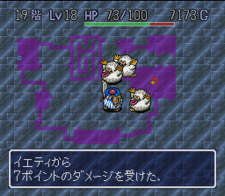Torneko no Daibōken: Fushigi no Dungeon
Torneko no Daibōken: Fushigi no Dungeon[lower-alpha 1] is the first game in the Mystery Dungeon series. It features Torneko (or Taloon, as he is known in North America), the merchant from Dragon Warrior IV, and his adventures around the Mystery Dungeon in search of items.
| Torneko no Daibōken: Fushigi no Dungeon | |
|---|---|
 Cover art | |
| Developer(s) | Chunsoft |
| Publisher(s) | Chunsoft |
| Director(s) | Tadashi Fukuzawa |
| Producer(s) | Koichi Nakamura |
| Designer(s) | Yuji Horii Kumiko Harada |
| Programmer(s) | Takenori Yamamori |
| Artist(s) | Akira Toriyama |
| Writer(s) | Yuji Horii |
| Composer(s) | Koichi Sugiyama |
| Series | Mystery Dungeon Dragon Quest |
| Platform(s) | Super Famicom |
| Release |
|
| Genre(s) | Role-playing video game, roguelike |
| Mode(s) | Single-player |
Gameplay

The gameplay is similar to roguelike-style PC games. The main similarity is the heavy use of randomized dungeons and effects. The main character of the game is Torneko, originally localized as Taloon in North America, a merchant and playable character from Dragon Warrior IV.[1] The player continues his story from Dragon Quest IV, where he wishes to make his store famous and ventures into mystery dungeons to retrieve items to stock in his store.
While Torneko explores the dungeons, he collects items and fights monsters, similar to ones found in Dragon Quest games. If he leaves the dungeon, he can sell off the items he found. He can also equip certain items. By saving up money, he can improve his home and shop.
Development
Torneko was developed by Chunsoft, the developers for the first five Dragon Quest games.[2] It was the first game in the Mystery Dungeon series of roguelike games, of which over 25 have been produced, including 5 Dragon Quest spinoffs. A PAL prototype originating in Germany was unearthed, proving that it was far in development. Tasked with creating one of the first “rogue-like” games for a console instead of a PC, Dragon Quest programmer Koichi Nakamura initially asked for permission to use the ‘’Dragon Quest’’ games as the template.[3] Letting players explore a familiar setting was part of lowering the difficulty and attempting to broaden the appeal of the genre.[3]
One major change from the normal ‘’Dragon Quest’’ game was the replacement of the hero, who normally had a grand mission to save the world, with the kind of person who would go hunting for treasure in dungeons.[3] For this reason, Nakamura chose Torneko, the well loved shopkeeper from Dragon Quest IV, imagining that he was exploring for items to put in his shop.[3] The “permadeath” featured in most rogue-like games, where the game starts over if the player character dies, was also softened so that the player does not completely start over, but becomes level one again and has a new dungeon to complete.[3]
Music
As with other games in the Dragon Quest series, the musical score for the game was written by Koichi Sugiyama. Sony Records released the soundtrack, titled Suite Torneko's Great Adventure: Musical Chemistry, on October 21, 1993 in Japan. It contains eight arranged tracks performed by a chamber orchestra, as well as three tracks containing original game music. The album was reprinted on October 7, 2009.[1] Two pieces of music from the game were performed by the Tokyo City Philharmonic Orchestra at the Game Music Concert 3, the year of the game's release.[4]
Release
The game was promoted with an exceptionally high-budget television commercial. It had a running time of 30 seconds (unusually long for Japanese commercials of the time) and consisted almost entirely of claymation footage filmed to run at 24 frames per second.[5]
Reception
| Reception | ||||||||
|---|---|---|---|---|---|---|---|---|
| ||||||||
In November 1993, Famitsu magazine's Reader Cross Review gave the game a 9 out of 10.[6] In 2006, the game was voted number 78 by the readers of Famitsu magazine in its top 100 games of all time.[8]
The game spawned two sequels starring Torneko, Torneko: The Last Hope in 1999 and Dragon Quest Characters: Torneko no Daibōken 3 in 2002, and a follow-up, Dragon Quest: Shōnen Yangus to Fushigi no Dungeon in 2006, where Torneko would appear as a cameo instead of the protagonist. And indeed, the game became the first of the over thirty Mystery Dungeon rogue-like series.[9]
Notes
- Torneko no Daibōken Fushigi no Danjon (トルネコの大冒険 不思議のダンジョン, lit. Torneko's Great Adventure: Mystery Dungeon)
References
- Gann, Patrick. "RPGFan Soundtracks - Suite Torneko's Great Adventure ~Musical Chemistry~". RPGFan.com. Archived from the original on 2010-11-30. Retrieved 2010-08-05.
- Matthew Williamson (2006). "Fushigi no Dungeon 2". Archived from the original on September 12, 2007. Retrieved September 2, 2007.
- Parish, Jeremy (January 17, 2019). "Roguelikes: How a Niche PC RPG Genre Went Mainstream". US Gamer. Archived from the original on February 13, 2020. Retrieved April 19, 2020.
- "Orchestral Game Concert 3 : Soundtrack Central". SoundtrackCentral.com. Archived from the original on 2015-10-17. Retrieved 2008-12-25.
- "International Outlook". Electronic Gaming Monthly (53). EGM Media, LLC. December 1993. p. 94.
- 読者 クロスレビュー: トルネコの大冒険 ~不思議のダンジョン~. Weekly Famicom Tsūshin. No.257. Pg.40. 12–19 November 1993.
- 超絶 大技林 '98年春版: スーパーファミコン - トルネコの大冒険 不思議のダンジョン. PlayStation Magazine (Special) (in Japanese). 42. Tokuma Shoten Intermedia. 15 April 1998. p. 344. ASIN B00J16900U.
- Edge staff (March 3, 2006). "Japan Votes on All Time Top 100". Edge-Online.com. Archived from the original on July 31, 2009. Retrieved 2008-12-13.
- Fahey, Mike (July 26, 2016). "Shiren The Wanderer is a Mystery Dungeon Game Without Pokémon or Chocobos, That's All". Kotaku UK. Retrieved April 22, 2020.